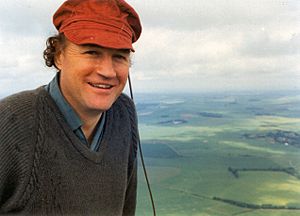Edward Thomas Hall facts for kids
Quick facts for kids
Edward Thomas Hall
|
|
|---|---|

In a balloon
|
|
| Born | 10 May 1924 |
| Died | 11 August 2001 (aged 77) |
| Nationality | British |
| Alma mater | New College, Oxford (Chemistry) |
| Spouse(s) | Jennifer De La Harpe |
| Children | Bill Hall Martin Hall |
| Awards | Commander of the Order of the British Empire Fellow of the British Academy |
| Scientific career | |
| Fields | Archaeological science |
Edward Thomas Hall, often called Teddy Hall, was a clever British scientist. He was born on May 10, 1924, and passed away on August 11, 2001. He is famous for proving that the "Piltdown Man" fossil was actually a fake. He was also a keen hot-air balloon pilot!
Contents
Early Life and School
Teddy Hall grew up in a big old house called Shipton Court in Oxfordshire. He went to a special school for boys called Eton College.
In 1943, during the Second World War, he joined the navy. He helped transport soldiers to France on landing crafts.
After the war, he went to New College, Oxford University. He studied chemistry there and earned his first degree in 1948. Later, he continued his studies and got a PhD in 1953. His advanced research was about using X-rays to study old objects without damaging them. This was very useful for archaeology.
Career in Science
In 1954, Teddy Hall became the director of a brand new place. It was called the Research Laboratory for Archaeology and the History of Art at University of Oxford. This lab used science to learn more about history and old artworks.
He became a professor in 1975, teaching about archaeological sciences. He retired from the lab in 1989.
Teddy Hall also helped lead important groups. He was a trustee for famous places like the British Museum and the National Gallery. This meant he helped make important decisions for these museums.
Other Cool Activities
Teddy Hall loved hot-air balloons. He owned his own balloon called Flaming Pearl. He flew it from 1970 to 1990.
In 1962, he worked with his friend, Robin Cavendish. Robin was paralyzed and needed a machine to help him breathe. Teddy Hall helped design a special wheelchair for Robin. This chair had a built-in breathing machine. It allowed Robin to leave his bed and move around. This invention was very important. It became a model for similar devices that helped many other people. Their story was even made into a movie called Breathe in 2017.
Amazing Achievements
- He helped expose the Piltdown Man as a fraud. This led him to start the Research Laboratory for Archaeology and the History of Art at Oxford University.
- He started his own science company called Littlemore Scientific Engineering Company (ELSEC).
- He helped figure out the age of the Shroud of Turin. Using scientific methods, he showed it was made between 1260 and 1390.
- In the 1990s, he built the Littlemore Clock. It is known as one of the most accurate pendulum clocks ever made.
|
Family Life
Teddy Hall married Jennifer De La Harpe, who was a model from South Africa. They had two sons together, named Bill and Martin.
Awards and Recognition
In 1951, Teddy Hall became a Fellow of the Physical Society. This is a special honor for scientists. In 1984, he was also made an Honorary Fellow of the British Academy. This award recognized his important work in humanities and social sciences.

